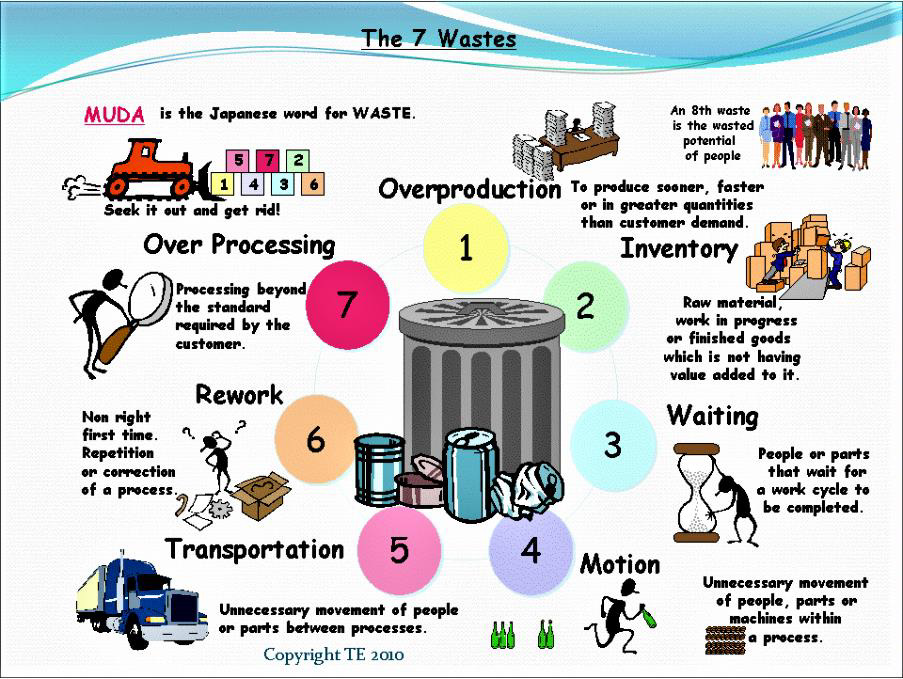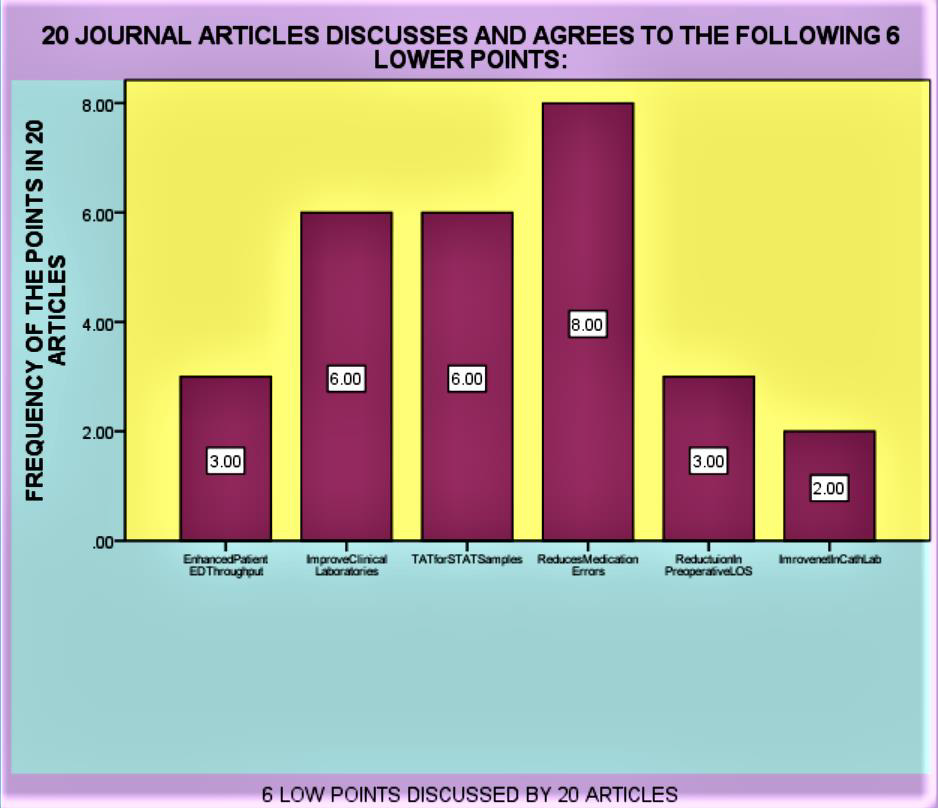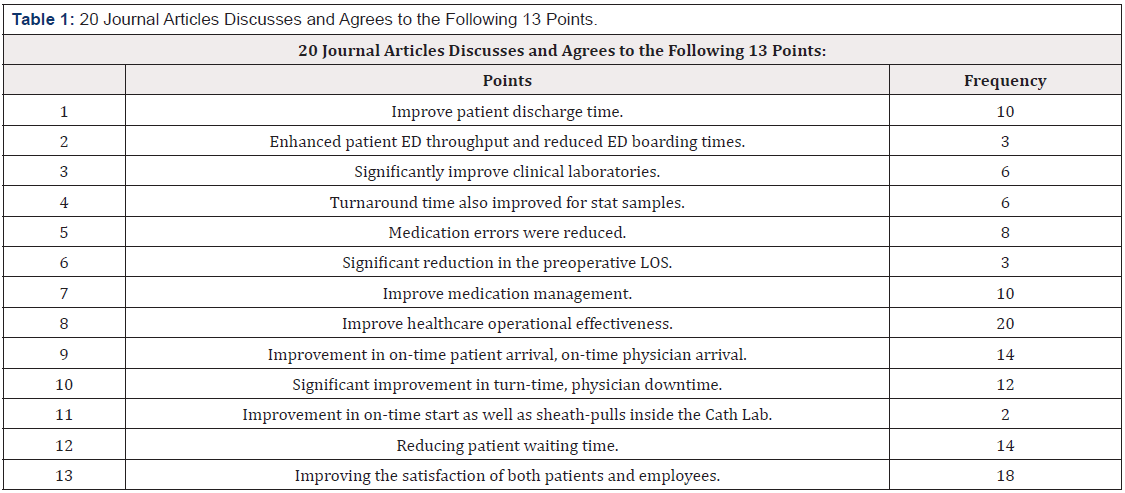Research Article 
 Creative Commons, CC-BY
Creative Commons, CC-BY
Examples of Lean Management or Lean Six Sigma Methodology to Improve Health Care and Patient Safety Standards in the Health Department
*Corresponding author: Ahsan Ali Siddiqui, Consultant Preventive Medicine and Epidemiologist, General Directorate of Health Riyadh City, Quality Management and Patient Safety Dept. Ministry of Health, Riyadh Saudi Arabia.
Received: November 11, 2021; Published: November 23, 2021
DOI: 10.34297/AJBSR.2021.14.002045
Abstract
Background and Objective: The main theme of this article is to discuss the Examples of Lean Management or Lean Six Sigma methodology to improve health care and patient safety standards in the health department.
Methods: The Author of this article has chosen literature review methodology of 20 PubMed randomly selected articles and few quality management websites. The author has chosen 13 points of benefits from the lean management and lean six sigma application in health care sector. The frequency of each beneficial point is noted and represented in the SPSS diagram for data analysis and data representation. The chosen PubMed articles and websites discusses the benefits of Lean management and lean six sigma application in the health industry.
Results: The results of this article are shown in the Table and SPSS Diagrams for the data presentation. The Table shows the (20 Journal Articles discusses and agrees to the 13 points) where the 13 points represents benefits from the lean management and lean six sigma application in health care sector. The two SPSS Diagrams shows the 20 Articles discusses and agrees the 7 high beneficial points and 6 low beneficial points from the lean management and lean six sigma application in health care sector.
Conclusion: To sum up, Lean management and Lean six sigma methodology has shown promising results to improve the quality of health care system. Lean six sigma methodology works by reducing 8 wastes including overproduction, inventory, waiting, Motion, Transportation, rework, over processing and non-utilized talent. Lean management is an approach to manage an organization that support the concept of continuous improvement. The 5 principles of lean model include value, value stream, flow, pull and perfection. Lean methodology relies on three simple ideas such as deliver value, Eliminate waste and continuous improvement.
Keywords: Lean thinking, Literature review, Process efficiency, Quality management, Six Sigma, Continuous quality improvement, ED boarding, Lean, Capacity management, Discharge time, Process improvement
Introduction
Lean is a quality improvement management system [1] from the Toyota manufacturing industry. Since the early 2000’s, Lean has been used as an intervention for healthcare improvement. Lean is intended to reduce costs and improve customer value through continuous improvement. Despite its extensive use, the contextual factors and mechanisms that influence the sustainability of Lean in healthcare have not been well studied. Realist synthesis is one [1] approach to “unpack” the causal explanations of how and why Lean is sustained or not in healthcare.
We have identified two defining characteristics [2] of Lean health-care management: [2] Lean philosophy, consisting of Lean principles and continuous improvement, and [1] Lean activities, which include Lean assessment activities and Lean improvement activities. The resulting operational definition requires that an organization or subunit of an organization had integrated Lean philosophy into the organization’s mandate, guidelines, or policies and utilized at least one Lean assessment activity or Lean improvement activity. To our knowledge, this is the [2] first evidence-based operational definition of Lean management in health care (Figure 1).
Lean healthcare is highlighted in the literature as an (Cory Hallam and Carolina Contreras, 2018) approach to quality improvement and operational efficiency. Evidence suggests that Lean can improve healthcare operational effectiveness. However, empirical studies show implementation is still highly localized with small successes. Most transformations are focused on implementing one or two Lean tools that primarily target patient waiting times and there is minimal evidence about sustainability. Establishing clear definitions for healthcare-related (Cory Hallam and Carolina Contreras, 2018) Lean terminology may improve practice, especially episodic care and service quality (Figure 2).

Figure 1: (Lean manufacturing tools, 2021) Lean healthcare is highlighted in the literature as an [3] approach to quality improvement and operational efficiency. Evidence suggests that Lean can improve healthcare operational effectiveness. However, empirical studies show implementation is still highly localized with small successes. Most transformations are focused on implementing one or two Lean tools that primarily target patient waiting times and there is minimal evidence about sustainability. Establishing clear definitions for healthcare-related [3] Lean terminology may improve practice, especially episodic care and service quality.
Methods
The Author of this article has chosen literature review methodology of 20 PubMed randomly selected articles and few quality management websites. The author has chosen 13 points of benefits from the lean management and lean six sigma application in health care sector [3-5]. The frequency of each beneficial point is noted and represented in the SPSS diagram for data analysis and data representation. The chosen PubMed articles and websites discusses the benefits of Lean management and lean six sigma application in the health industry.
Lean and Six Sigma can be considered [6] valuable process optimization approaches in acute health care settings. The success of their implementation requires significant participation of clinical personnel from the frontline as well as clinical leaders and managers. More research is needed to better understand the factors of success and the barriers to their implementation, [6] as well as their long-term impact.
Lean, Six Sigma, and Lean Sigma as QI approaches [7] aid institutions in tackling a wide variety of problems encountered in acute care. However, the true impact of these approaches is difficult to judge, given that the lack of rigorous evaluation or clearly sustained improvements provides little evidence supporting broad adoption. There is still a need for future work that will improve the evidence base for understanding more about [7] QI approaches and how to achieve sustainable improvement.
The relationship between organizational culture [8] and Lean Six Sigma in hospitals provides information on how specific cultural characteristics impact the Lean Six Sigma initiative key components. This information assists hospital staff who are considering implementing quality initiatives by providing an understanding of what cultural values correspond to effective Lean Six Sigma implementation. Managers understanding the quality initiative cultural underpinnings, are attentive to the culture-shared values [8] and norm’s influence can utilize strategies to better implement Lean Six Sigma.
The Lean Six Sigma general principles applied [9] in this project to develop recommendations to improve medication management for dual care veterans are applicable to any process improvement or redesign project and has valuable lessons for other VAMCs seeking to improve care for their dual care veteran patients. The findings of this project will be of value to VA providers and policy makers and health care managers who plan to apply [9] Lean Six Sigma techniques in their organizations to improve the quality of care for their patients.
Measure and statistical Analysis
Table 1 and Figure 3-4
Results
The results of this article are shown in the Table 1 and SPSS Diagrams for the data presentation. The Table 1 shows the (20 Journal Articles discusses and agrees to the 13 points) where the 13 points represents benefits from the lean management and lean six sigma application in health care sector. The two SPSS Diagrams shows the 20 Articles discusses and agrees the 7 high beneficial points and 6 low beneficial points from the lean management and lean six sigma application in health care sector.
Lean Six Sigma was applied to the areas of clinical medicine [10] (including general medicine, pulmonology, oncology, nephrology, cardiology, neurology, gastroenterology, rheumatology, and diabetology), and data regarding HAIs were collected for 28,000 patients hospitalized between January 2011 and December 2016. Lean Six Sigma proved to be a useful tool for identifying variables affecting the risk of HAIs and implementing corrective actions to improve the performance of the care process [10]. Implementation of an LSS approach could significantly decrease the percentage of patients with HAIs.
A Lean Six Sigma methodology, based on the [11] DMAIC cycle (Define, Measure, Analyze, Improve, Control), is implemented to evaluate the effectiveness of the DTAP. The statistics of the process measured before the DTAP showed an average preoperative LOS of 5.6 days (standard deviation of 3.2), thus confirming the need for corrective actions to reduce the LOS in compliance with the national guidelines. The influence of demographic and anamnestic variables on the LOS was evaluated, and the impact of the DTAP was measured and discussed, demonstrating the effectiveness of the improvement actions implemented over the years and leading to a significant reduction in the [11] preoperative LOS, which decreased to an average of 3.5 days (standard deviation of 3.60).
Successful implementation of Lean Six Sigma [12] significantly improved all of the selected performance metrics. This qualityimprovement methodology has the potential to significantly improve clinical laboratories. The pre‐analytical process in the reception area was improved by eliminating 3 h and 22.5 min of non‐value‐adding work. Turnaround time also improved for stat samples from 68 to 59 min after applying Lean. Steps prone to [12] medical errors and posing potential biological hazards to receptionists were reduced from 30% to 3%.
Lean principles implemented by one hospital service line improved [13] discharge times enhanced patient ED throughput, and reduced ED boarding times. For the general pediatrics service line, the median discharge order entry time decreased from 1:43pm to 11:28am (p < 0.0001) and the median time of discharge decreased from 3:25pm to 2:25pm (p < 0.0001). The percent of patients discharged before noon increased from 14.0% to 26.0% (p < 0.0001). As a result, the median time of day [13] admitted patients were discharged from the ED was advanced from 5 PM to 4 PM.
After implementation of lean six sigma in the Cath Lab, [14] we observed a significant improvement in turn-time, physician downtime, on-time patient arrival, on-time physician arrival, ontime start as well as sheath-pulls inside the Cath Lab. The percentage of cases with optimal turn-time increased from 43.6% in 2009 to 56.6% in 2012 (p-trend<0.001). Similarly, the percentage of cases with an aggregate on-time start increased from 41.7% in 2009 to 62.8% in 2012 (p-trend<0.001). In addition, the [14] percentage of manual sheath-pulls performed in the Cath Lab decreased from 60.7% in 2009 to 22.7% in 2012 (p-trend<0.001).
Discussion
A QI program shaped by Lean Six Sigma principles and [15] reinforced by clinician huddles and geographic cohorting was associated with earlier posting of discharge orders and physical discharge by noon. After accounting for the concurrent trends in the control group, the percentage of discharge orders released by 10:00 a.m. increased by 21.3 points (p < 0.001; adjusted odds ratio [OR] = 2.62; 95% confidence interval [CI] = 1.91-3.59), and the percentage of [15] patients discharged by noon increased by 7.5 points (p = 0.001; adjusted OR = 1.70; 95% CI 1.15-2.51).
Several health services have used lean healthcare [16] to seek continuous improvement of their processes. As an integrative literature review methodology was used, it was conducted in five databases, using the descriptor “quality improvement” and the keyword “Lean Healthcare”. The most recurrent tools were: define, measure, analyze, improve and control (DMAIC); value stream map (VSM); suppliers, inputs, process, outputs, customers analysis (SIPOC), Ishikawa Diagram and 5S. Through the analysis of waste, different interventions were implemented and the main results achieved were [16] reduction in times (processing, waiting, cycle and total), costs, workload and increase in the number of calls.
LEAN is quite a new concept in Finnish public healthcare [17]. It is mainly used as a development tool to seek financial savings and to improve the efficiency of patient processes, but has not yet been deeply implemented. However, the experiences from LEAN initiatives have been positive, and the methodology is already quite well-known. It can be concluded that, because of positive experiences from LEAN, the environment in [17] Finnish healthcare is ready for the deeper implementation of LEAN.
Healthcare is a unique service industry [18] and it deals with complex tasks. To overcome complex tasks, healthcare organizations need to implement DMAIC (Define, Measure, Analyze, Improve, Control) approach of Lean Six Sigma (LSS) to improve quality performance. Application of DMAIC in a healthcare organization provides guidelines on how to handle a quality service system toward patient satisfaction. This approach also helps healthcare service [18] providers to reduce waste, variation and work imbalance in the service processes.
Application of lean management in an outpatient pharmacy [19] was effective in reducing patient waiting time and improving the satisfaction of both patients and employees. Patient waiting time for prescriptions of fewer than 3 medications and of 3 medications or more decreased significantly (22.3 minutes vs 8.1 minutes, P < .001-, and 31.8-minutes vs 16.1 minutes, P < .002, respectively), and patient satisfaction increased (62% vs 69%; P = .005) after full implementation of the project. The majority of the pharmacy staff reported that the process motivated them in their work and that [19] both their jobs and their relationships with their managers and colleagues had improved.
Six Sigma and Lean are two quality improvement methodologies. The Lean Six Sigma methodology is applicable to repetitive procedures. Therefore, the use of this methodology in the health care arena has focused mainly on areas of business operations, throughput, and case management and has focused on efficiency outcomes. After the revision of methodology, the paper presents a brief clinical example of the use of Lean Six Sigma as a quality improvement method in the reduction of the complications during and after lobectomies. Using Lean Six Sigma methodology, the multidisciplinary teams could identify multiple modifiable points across the surgical process.
Conclusion
To sum up, Lean management and Lean six sigma methodology has shown promising results to improve the quality of health care system. Lean six sigma methodology works by reducing 8 wastes including overproduction, inventory, waiting, Motion, Transportation, rework, over processing and non-utilized talent. Lean management is an approach to manage an organization that support the concept of continuous improvement. The 5 principles of lean model include value, value stream, flow, pull and perfection. Lean methodology relies on three simple ideas such as deliver value, Eliminate waste and continuous improvement.
Conflict of Interest
None
Disclosure
The author declares no conflict of interest in preparing this article. This study is the author’s independent research. There is no any interest to disclose.
References
- Rachel Flynn, Amanda S Newton, Thomas Rotter, Dawn Hartfield, Sarah Walton, et al. (2018) The sustainability of Lean in pediatric healthcare: a realist review. Systematic Reviews.
- Thomas Rotter, Christopher Plishka, Adegboyega Lawal, Liz Harrison, Nazmi Sari, et al. (2019) What Is Lean Management in Health Care? Development of an Operational Definition for a Cochrane Systematic Review. Eval Health Prof 42(3): 366-390.
- Cory Hallam, Carolina Contreras (2018) Lean healthcare: scale, scope and sustainability. Int J Health Care Qual Assur 31(7): 684-696.
- Lean manufacturing tools (2021) Just in time production.
- Grey Campus (2021) A Brief Introduction To Lean, Six Sigma And Lean Six Sigma.
- Simon Deblois, Luigi Lepanto (2016) Lean and Six Sigma in acute care: a systematic review of reviews. Int J Health Care Qual Assur 29(2):192-208.
- Justin M Glasgow, Jill R Scott Caziewell, Peter J Kaboli (2010) Guiding inpatient quality improvement: a systematic review of Lean and Six Sigma. Jt Comm J Qual Patient Saf 36(12): 533-540.
- Susan Knapp (2015) Lean Six Sigma implementation and organizational culture. Int J Health Care Qual Assur 28(8): 855-863.
- Preethy Nayar, Diptee Ojha, Ann Fetrick, Anh T Nguyen (2016) Applying Lean Six Sigma to improve medication management. Int J Health Care Qual Assur 29(1): 16-23.
- Giovanni Improta, Mario Cesarelli, Paolo Montuori, Liberatina Carmela Santillo, Maria Triassi (2018) Reducing the risk of healthcare‐associated infections through Lean Six Sigma: The case of the medicine areas at the Federico II University Hospital in Naples (Italy). J Eval Clin Pract 24(2): 338-346.
- Arianna Scala, Alfonso Maria Ponsiglione, Ilaria Loperto, Antonio Della Vecchia, Anna Borrelli, et al. (2021) Lean Six Sigma Approach for Reducing Length of Hospital Stay for Patients with Femur Fracture in a University Hospital. Int J Environ Res Public Health 18(6): 2843.
- Tamer I, Ozlem G O, Filiz K, Salih C, Selcuk Matyar, et al. (2018) Lean six sigma methodologies improve clinical laboratory efficiency and reduce turnaround times. J Clin Lab Anal 32(1): e22180.
- Michael J Beck, Davin Okerblom, Anika Kumar, Subhankar Bandyopadhyay, Lisabeth V Scalzi (2016) Lean intervention improves patient discharge times, improves emergency department throughput and reduces congestion. Hosp Pract 44(5): 252-259.
- Shikhar Agarwal, Justin J Gallo, Akhil Parashar, Kanika K Agarwal, Stephen G Ellis, et al. (2016) Impact of lean six sigma process improvement methodology on cardiac catheterization laboratory efficiency. Cardiovasc Revasc Med 17(2): 95-101.
- Mithu Molla, Duncan S Warren, Susan Leroy Stewart, Jacqueline Stocking, Hershan Johl, et al. (2018) A Lean Six Sigma Quality Improvement Project Improves Timeliness of Discharge from the Hospital. Jt Comm J Qual Patient Saf 44(7): 401-412.
- Letícia Bianchini de Barros, Letícia de Camargo Bassi, Laura Passos Caldas, Alice Sarantopoulos, Eliete Boaventura Bargas Zeferino, et al. (2021) Lean Healthcare Tools for Processes Evaluation: An Integrative Review. Int J Environ Res Public Health 18(14): 7389.
- Tapani Jorma, Hanna Tiirinki, Risto Bloigu, Leena Turkki (2016) LEAN thinking in Finnish healthcare. Leadersh Health Serv (Bradf Engl) 29(1): 9-36.
- Selim Ahmed (2019) Integrating DMAIC approach of Lean Six Sigma and theory of constraints toward quality improvement in healthcare. Rev Environ Health 34(4): 427-434.
- Suzan Hammoudeh, Abdullah Amireh, Saad Jaddoua, Lama Nazer, Enas Jazairy, et al. (2021) The Impact of Lean Management Implementation on Waiting Time and Satisfaction of Patients and Staff at an Outpatient Pharmacy of a Comprehensive Cancer Center in Jordan. Hosp Pharm 56(6): 737-744.
- Luca Bertolaccini, Andrea Viti, Alberto Terzi (2015) The Statistical point of view of Quality: the Lean Six Sigma methodology. J Thorac Dis 7(4): E66-E68.







 We use cookies to ensure you get the best experience on our website.
We use cookies to ensure you get the best experience on our website.